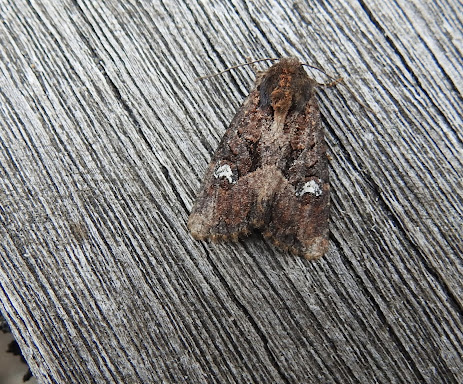I've been stuck indoors since my last post by a wide variety of excuses and events. The leg pain cleared up, only to be replaced by foot pain (probably a recurrence of my Morton's Neuroma) - strangely appropriate. Then there's the rain. And finally having to be in to accept supermarket deliveries.
The only light relief has been watching the Grey Squirrel tidying the garden by taking mouthfuls of leaves to build a drey, and a pair of Robins disappearing into our shed with beak-fulls of leaves, clearly nest building. This is likely to lead to conflict over the local moths when the trap goes out in Spring.
And speaking of moths......when an email arrived from Nigel Stone this morning with the results of his dissections of last year's tricky moths, I was delighted to have something to do.
Obviously there's the thorny issue of taking specimens to deal with first. I would only say that two of the following moths simply expired before I was able to release them (so I might as well have got their identity checked), and as for the others, unfortunately there was no other way of determining what they were with certainty. I keep such activity to an absolute minimum.
Anyway; two were new for the 10km square. The Lesser Common Rustic (which was found dead in the trap), and Mompha bradleyi (a really cryptic micro which was only discovered to be living in the UK in the 1990's when someone realised that some specimens of Mompha divisella in Herefordshire were actually M bradleyi.) They have since been found in various parts of the South Midlands, but I'm not sure how widespread they are in Warwickshire. In fact I have now learnt that this was the fifth record for the county.
 |
| Lesser Common Rustic |
 |
| Mompha bradleyi |
The remaining moths were also garden ticks: A Red-line Quaker which I unfortunately only took a terrible photo of before finding it dead the following morning (it was extremely worn), a Parornix scoticella which isn't featured in my micro-moth book and which UK Moth ID told me could not be identified from my photograph. They are nevertheless not particularly rare. A Coleophora serratella, unfortunately none of the Coleophora moths can be identified without dissection. This is apparently the commonest of that group. And finally a Caloptilia robustella which was a very pretty little micro moth which would have had to remain robustella ag without Nigel's confirmation of species.
In total last year I recorded 25 species which were new for the 10km square our garden sits in. Most were micros, probably reflecting the limited appeal micros have to some moth-ers, but there were also five macros: Lesser Common Rustic, Rufous Minor, Cypress Pug, Slender Brindle, and Olive.
Finally, I saw Mike Lane's footage of a Redwing eating Sloes on the BBC's Winterwatch yesterday. I am fairly sure it was filmed at Morton Bagot.
Sam is still watching birds at Morton Bagot, and saw 50 Lapwings and a Shoveler there yesterday.
No comments:
Post a Comment